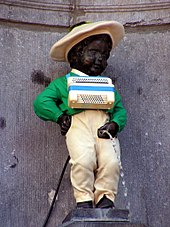Manneken Pis
The Manneken Pis ( Brabantian for "pissing man"), also called le Petit Julien , is a fountain figure of a boy urinating. It is one of the landmarks of the Belgian capital, Brussels .
history
The 61 centimeter high bronze statue on the corner of rue de l'Etuve / Stoofstraat, rue des Grands Carmes / Lievevrouwbroerstraat and rue du Chêne / Eikstraat was created in 1619 by the Brussels sculptor Jérôme Duquesnoy . The motif of the watering boy as a drolerie had been known in the Duchy of Brabant for centuries. The statue of a peeing boy is documented as early as the 15th century. The later bronze figure was repeatedly stolen and badly damaged; the current statue is a copy from 1965.
The original is said to be kept in the Maison du Roi merchant's house on Grand-Place / Grote Markt . However, while researching a doctoral thesis on the landmark, doubts arose as to its authenticity. Former student Geraldine Patigny suspected that a copy was put up after the theft in 1817. The statue was examined in detail in 2015 and is displayed on a gold base.
A text from 1388 in the archives of the St. Michael and St. Gudula Cathedral in Brussels already mentions a small stone statue called "Julianekensborre" at a fountain at the corner of rue de l'Etuve and rue du Chêne. At that time there were many such wells in Brussels that supplied the city with drinking water. The name "Manneken Pis" first appeared around 1450 in texts from the Brussels City Archives.
In 1985 Manneken Pis got a female counterpart with Jeanneke Pis and in 1998 a dog as a counterpart with Zinneke Pis .
In March 2019 it became known that the Manneken Pis does not have a closed water cycle like most of the fountains, which was wrongly assumed. Since it was erected in 1619, the statue has poured between 1500 and 2500 liters of drinking water into the canal every day. The Brussels City Council responded by creating a closed system.
meaning
Today, the Manneken Pis is no longer just a symbol for Brussels and Belgium, which is a fact that exhibitions repeatedly address. The statue in the center of the “political capital” of the European Union would represent freedom of expression, the spirit of resistance and democratic values. This was last shown in 2016 after the terrorist attacks in Brussels on March 22, 2016 : Images were immediately spread via social networks showing the man urinating on the terrorists. These pictures are reminiscent of a drawing from 1944, on which the Manneken pees on the German Wehrmacht soldiers fleeing Brussels and a large swastika.
Costumes
The statue is clothed from time to time. For example, she poses in the shirt of the Belgian national football team at international matches or is disguised accordingly on the birthdays of Elvis Presley or Wolfgang Amadeus Mozart . On World AIDS Day , she was given condoms . There are more than 950 different costumes.
In 1698, the then Habsburg governor of the Spanish Netherlands Maximilian II Emanuel started the costumes. After Jacques Stroobants was responsible for the costumes for more than 20 years, Jean-Marc Ahim took over this task in May 2005. This was preceded by a violent dispute between the city of Brussels and his predecessor.
At the beginning of February 2017, the new GardeRobe MannekenPis museum opened a few meters from the fountain , showing 133 of the more than 950 costumes that are now available. The curator is Gonzague Pluvinage. If you want to give the Manneken a costume, you have to submit an application to the Council of Mayors and Aldermen of the City of Brussels, a commission checks on the basis of rules that prohibit design for political, religious or commercial purposes. The Manneken Pis also receives new costumes as a diplomatic gift: Japan tops the international ranking with 18 robes presented.
More copycat figures
There are other similar statues in Geraardsbergen, Belgium, and in Duisburg . The latter was modeled in 1908 by the sculptor August Kraus as a gift for his hometown Ruhrort , initially spurned for “moral reasons”, but in the 1930s it was erected next to the former Tonhalle on König-Heinrich-Platz opposite the Duisburg court. From 1952 it was initially at the east exit of the main train station and later on Sonnenwall.
Another figure can be found in Bogense on the Danish island of Funen . It was donated in 1934 by a foundling who grew up there.
Another figure stands on one of the platforms in the Japanese Hamamatsuchō train station in Tokyo's Minato district .
Web links
- Manneken Pis. Commune Libre de l'Îlot Sacré, accessed on March 26, 2019 (French).
literature
Geert van Istendael: Manneke Pis , Brussels 2010
Individual evidence
- ↑ a b c Christoph Driessen: History of Belgium. The divided nation. Regensburg 2018, pp. 80–81
- ↑ Geert van Istendael: Manneke Pis . Antwerp 2010, p. 8
- ↑ Researchers investigate the authenticity of Manneken Pis. ORF.at , August 6, 2015, accessed on March 26, 2019 .
- ↑ Manneken Pis no longer a pass-through pee. ORF.at, March 26, 2019, accessed on March 26, 2019 .
- ↑ Geert van Istendael: Manneke Pis . Antwerp 2010, p. 82
- ↑ Helmut Hetzel: Will Manneken Pis have to freeze soon? Kölner Stadt-Anzeiger, August 26, 2005, accessed on March 26, 2019 .
- ^ Museum of Manneken Pis' Robes opens in Brussels. ORF.at, February 4, 2017, accessed on March 26, 2019 .
- ^ Manneken Pis, Bogense. Nordfyns Turistbureau, accessed March 26, 2019 .
Coordinates: 50 ° 50 ′ 42 ″ N , 4 ° 21 ′ 0 ″ E



